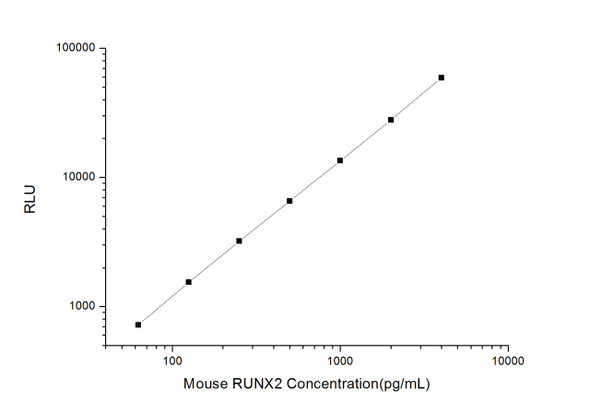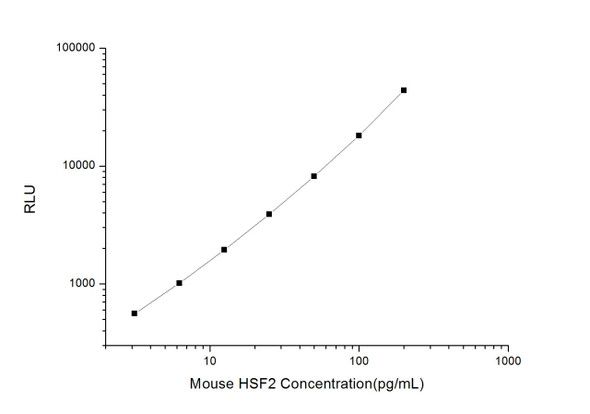Mouse Epigenetics and Nuclear Signaling ELISA Kits
Mouse GTF2H1 (General Transcription Factor IIH, Polypeptide 1) CLIA Kit (MOES00288)
- SKU:
- MOES00288
- Product Type:
- ELISA Kit
- ELISA Type:
- CLIA Kit
- Size:
- 96 Assays
- Sensitivity:
- 37.5pg/mL
- Range:
- 62.5-4000pg/mL
- ELISA Type:
- Sandwich
- Reactivity:
- Mouse
- Sample Type:
- Serum, plasma and other biological fluids
- Research Area:
- Epigenetics and Nuclear Signaling
Description
| Assay type: | Sandwich |
| Format: | 96T |
| Assay time: | 4.5h |
| Reactivity: | Mouse |
| Detection method: | Chemiluminescence |
| Detection range: | 62.50-4000 pg/mL |
| Sensitivity: | 37.50 pg/mL |
| Sample volume: | 100µL |
| Sample type: | Serum, plasma and other biological fluids |
| Repeatability: | CV < 15% |
| Specificity: | This kit recognizes Mouse GTF2H1 in samples. No significant cross-reactivity or interference between Mouse GTF2H1 and analogues was observed. |
This kit uses Sandwich-CLIA as the method. The micro CLIA plate provided in this kit has been pre-coated with an antibody specific to Mouse GTF2H1. Standards or samples are added to the appropriate micro CLIA plate wells and combined with the specific antibody. Then a biotinylated detection antibody specific for Mouse GTF2H1 and Avidin-Horseradish Peroxidase (HRP) conjugate are added to each micro plate well successively and incubated. Free components are washed away. The substrate solution is added to each well. Only those wells that contain Mouse GTF2H1, biotinylated detection antibody and Avidin-HRP conjugate will appear fluorescence. The Relative light unit (RLU) value is measured spectrophotometrically by the Chemiluminescence immunoassay analyzer. The RLU value is positively associated with the concentration of Mouse GTF2H1. The concentration of Mouse GTF2H1 in the samples can be calculated by comparing the RLU of the samples to the standard curve.
| UniProt Protein Function: | Component of the general transcription and DNA repair factor IIH (TFIIH) core complex, which is involved in general and transcription-coupled nucleotide excision repair (NER) of damaged DNA and, when complexed to CAK, in RNA transcription by RNA polymerase II. In NER, TFIIH acts by opening DNA around the lesion to allow the excision of the damaged oligonucleotide and its replacement by a new DNA fragment. In transcription, TFIIH has an essential role in transcription initiation. When the pre-initiation complex (PIC) has been established, TFIIH is required for promoter opening and promoter escape. Phosphorylation of the C-terminal tail (CTD) of the largest subunit of RNA polymerase II by the kinase module CAK controls the initiation of transcription. |
| UniProt Code: | Q9DBA9 |
| NCBI GenInfo Identifier: | 597517984 |
| NCBI Gene ID: | 14884 |
| NCBI Accession: | NP_001278004. 1 |
| UniProt Secondary Accession: | Q9DBA9,O35637, |
| UniProt Related Accession: | Q9DBA9 |
| Molecular Weight: | 61,851 Da |
| NCBI Full Name: | general transcription factor IIH subunit 1 isoform 1 |
| NCBI Synonym Full Names: | general transcription factor II H, polypeptide 1 |
| NCBI Official Symbol: | Gtf2h1 |
| NCBI Official Synonym Symbols: | p62; 62kDa; C77871; AW743425; AW822074; BTF2 p62 |
| NCBI Protein Information: | general transcription factor IIH subunit 1 |
| UniProt Protein Name: | General transcription factor IIH subunit 1 |
| UniProt Synonym Protein Names: | Basic transcription factor 2 62 kDa subunit; BTF2 p62; General transcription factor IIH polypeptide 1; TFIIH basal transcription factor complex p62 subunit |
| Protein Family: | General transcription factor |
| UniProt Gene Name: | Gtf2h1 |
As the RLU values of the standard curve may vary according to the conditions of the actual assay performance (e. g. operator, pipetting technique, washing technique or temperature effects), the operator should establish a standard curve for each test. Typical standard curve and data is provided below for reference only.
| Concentration (pg/mL) | RLU | Average | Corrected |
| 4000 | 53807 64355 | 59081 | 59046 |
| 2000 | 27643 28075 | 27859 | 27824 |
| 1000 | 14482 12486 | 13484 | 13449 |
| 500 | 6024 7186 | 6605 | 6570 |
| 250 | 3362 3124 | 3243 | 3208 |
| 125 | 1643 1519 | 1581 | 1546 |
| 62.50 | 752 758 | 755 | 720 |
| 0 | 34 36 | 35 | -- |
Precision
Intra-assay Precision (Precision within an assay): 3 samples with low, mid range and high level Mouse GTF2H1 were tested 20 times on one plate, respectively.
Inter-assay Precision (Precision between assays): 3 samples with low, mid range and high level Mouse GTF2H1 were tested on 3 different plates, 20 replicates in each plate.
| Intra-assay Precision | Inter-assay Precision | |||||
| Sample | 1 | 2 | 3 | 1 | 2 | 3 |
| n | 20 | 20 | 20 | 20 | 20 | 20 |
| Mean (pg/mL) | 199.84 | 502.06 | 1407.06 | 203.21 | 489.21 | 1350.16 |
| Standard deviation | 23.56 | 52.87 | 123.26 | 17.27 | 44.52 | 96.81 |
| C V (%) | 11.79 | 10.53 | 8.76 | 8.50 | 9.10 | 7.17 |
Recovery
The recovery of Mouse GTF2H1 spiked at three different levels in samples throughout the range of the assay was evaluated in various matrices.
| Sample Type | Range (%) | Average Recovery (%) |
| Serum (n=5) | 98-113 | 106 |
| EDTA plasma (n=5) | 91-105 | 98 |
| Cell culture media (n=5) | 98-112 | 104 |
Linearity
Samples were spiked with high concentrations of Mouse GTF2H1 and diluted with Reference Standard & Sample Diluent to produce samples with values within the range of the assay.
| Serum (n=5) | EDTA plasma (n=5) | Cell culture media (n=5) | ||
| 1:2 | Range (%) | 86-100 | 100-112 | 94-105 |
| Average (%) | 92 | 106 | 100 | |
| 1:4 | Range (%) | 91-103 | 86-99 | 96-112 |
| Average (%) | 98 | 93 | 103 | |
| 1:8 | Range (%) | 100-111 | 91-105 | 88-101 |
| Average (%) | 106 | 97 | 93 | |
| 1:16 | Range (%) | 89-103 | 92-105 | 100-114 |
| Average (%) | 96 | 99 | 108 |
An unopened kit can be stored at 4°C for 1 month. If the kit is not used within 1 month, store the items separately according to the following conditions once the kit is received.
| Item | Specifications | Storage |
| Micro CLIA Plate(Dismountable) | 8 wells ×12 strips | -20°C, 6 months |
| Reference Standard | 2 vials | |
| Concentrated Biotinylated Detection Ab (100×) | 1 vial, 120 µL | |
| Concentrated HRP Conjugate (100×) | 1 vial, 120 µL | -20°C(shading light), 6 months |
| Reference Standard & Sample Diluent | 1 vial, 20 mL | 4°C, 6 months |
| Biotinylated Detection Ab Diluent | 1 vial, 14 mL | |
| HRP Conjugate Diluent | 1 vial, 14 mL | |
| Concentrated Wash Buffer (25×) | 1 vial, 30 mL | |
| Substrate Reagent A | 1 vial, 5 mL | 4°C (shading light) |
| Substrate Reagent B | 1 vial, 5 mL | 4°C (shading light) |
| Plate Sealer | 5 pieces | |
| Product Description | 1 copy | |
| Certificate of Analysis | 1 copy |
- Set standard, test sample and control (zero) wells on the pre-coated plate and record theirpositions. It is recommended to measure each standard and sample in duplicate. Note: addall solutions to the bottom of the plate wells while avoiding contact with the well walls. Ensuresolutions do not foam when adding to the wells.
- Aliquot 100µl of standard solutions into the standard wells.
- Add 100µl of Sample / Standard dilution buffer into the control (zero) well.
- Add 100µl of properly diluted sample (serum, plasma, tissue homogenates and otherbiological fluids. ) into test sample wells.
- Cover the plate with the sealer provided in the kit and incubate for 90 min at 37°C.
- Aspirate the liquid from each well, do not wash. Immediately add 100µL of BiotinylatedDetection Ab working solution to each well. Cover the plate with a plate seal and gently mix. Incubate for 1 hour at 37°C.
- Aspirate or decant the solution from the plate and add 350µL of wash buffer to each welland incubate for 1-2 minutes at room temperature. Aspirate the solution from each well andclap the plate on absorbent filter paper to dry. Repeat this process 3 times. Note: a microplatewasher can be used in this step and other wash steps.
- Add 100µL of HRP Conjugate working solution to each well. Cover with a plate seal andincubate for 30 min at 37°C.
- Aspirate or decant the solution from each well. Repeat the wash process for five times asconducted in step 7.
- Add 100µL of Substrate mixture solution to each well. Cover with a new plate seal andincubate for no more than 5 min at 37°C. Protect the plate from light.
- Determine the RLU value of each well immediately.






